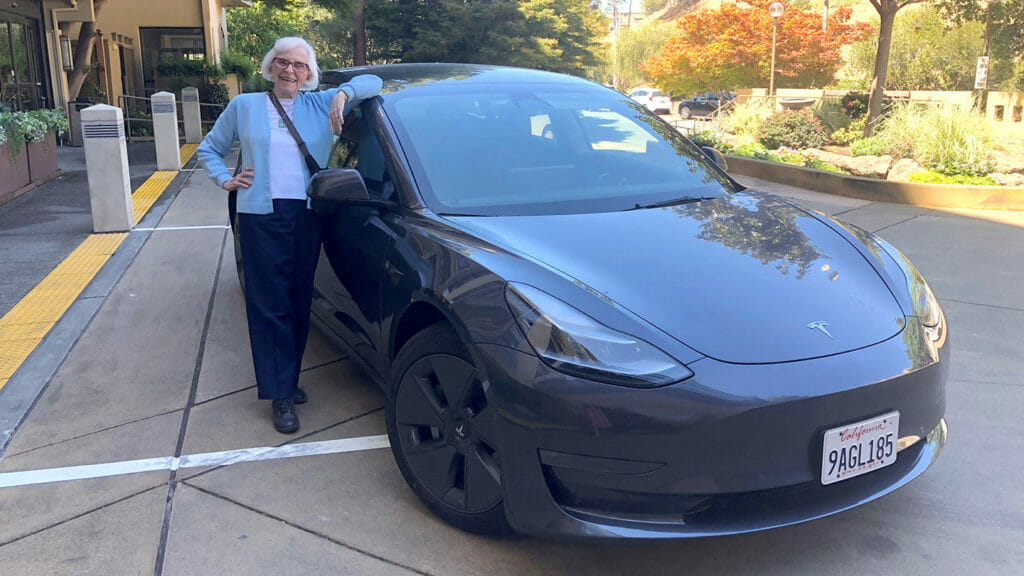
A California senior living community recently added an electric vehicle, as well as four charging stations, for resident transportation needs.
The resident environmental committee at Tamalpais Marin in Greenbrae, CA, a Sequoia Living continuing care retirement / life plan community, launched the initiative in an effort to make its community as energy-neutral as possible.
Tamalpais Marin has a Tesla Model 3 sedan and is in the process of buying an EV STAR PLUS, a 24-passenger electric bus. The electric vehicles will be driven by insured Tamalpais Marin drivers and will be able to be used by residents to get to medical appointments, activities and excursions.
The community also added four charging stations for the new vehicles and to accommodate the growing number of residents buying electric vehicles. A company spokeswoman told McKnight’s Senior Living that six residents own electric vehicles, and more are planning to buy them.
Sequoia Director of Environmental Services Steward Dalie researched options and installed the charging stations in response to residents’ needs, but guests, employees and service providers also are welcome to use them.
The electric vehicles emit fewer greenhouse gasses and air pollutants and contribute positively to local air quality. They also reduce noise pollution and are low-maintenance, according to the Sequoia Living spokeswoman.
The vehicle purchases are the latest of several environmental initiatives the community began in 2018. The community also offers composting, recycling and food waste management programs to divert waste and pollutants from landfills. Tamalpais is one of the largest senior living communities in Marin County to comply with California’s new bill requiring recycling and composting, according to the company.
The senior living community also brings in rescued goats to graze on its grounds to help create buffer space to mitigate fire danger. The company said that the goats reduce the use of machinery, noise pollution and invasive or toxic weeds, and they also reduce fuel and insurance costs. And a herd of goats eats 50,000 feet of grass per day, reducing landscape maintenance costs, according to the spokeswoman.
The bigger picture
Sequoia Living launched a Climate Change advisory committee this year that includes employees, residents and other stakeholders, including older adult volunteers and donors. The committee’s role is to oversee the company’s Legacy Talks and offer ideas and guidance on topics, speakers and communication methods to engage older adults in the greater Bay area.
The Legacy Talks webinar series is designed to inform, educate and advocate for healthier living. A Sequoia Living spokeswoman said the company is dedicated to sustainability through initiatives that affect pollution and water use, reduce food waste and alleviate dependency on the utility grid.
Other Sequoia Living communities in California also are adopting environmental initiatives. At the Sequoias Portola Valley, 2,600 solar panels will be installed and will produce 1.5 megawatts of power, generating 105% of the electrical needs of the community. The plan is to take the community completely off the electricity grid.
Co-generation — involving the generation of electricity and other energy jointly, especially the use of the steam left over from electricity generation to produce heat — is in place at the Tamalpais, Portola Valley and Sequoia San Francisco locations.
Sequoia Living’s Viamonte at Walnut Creek, the operator’s newest CCRC, is a platinum LEED-certified community.
Other companywide environmental initiatives include the conversion of 50% of building lighting to LED lights, with plans to continue upgrading lighting for energy efficiency.
“We’ve taken action by creating our own electricity to reduce the dependency on the grid, we work with our partners on food waste and emission reduction, and now we are installing solar panels on one of our communities to improve its efficiency,” Ray Boudewyn, vice president of facilities and procurement, said during a Legacy Talk.




